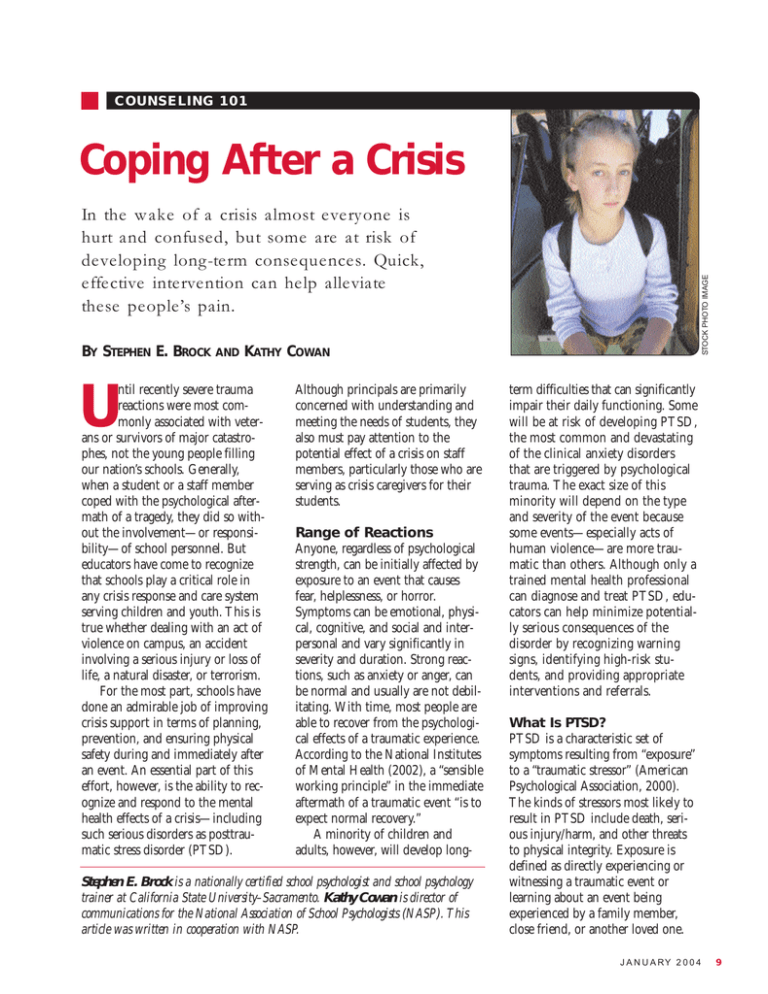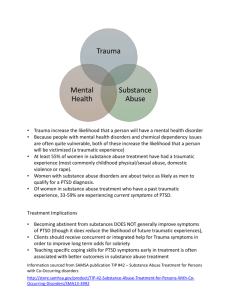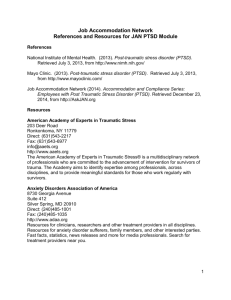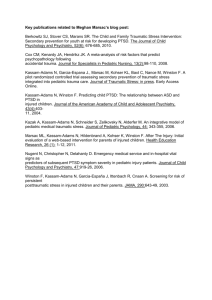U
advertisement

COUNSELING 101 Coping After a Crisis BY STEPHEN E. BROCK U AND STOCK PHOTO IMAGE In the wake of a crisis almost everyone is hurt and confused, but some are at risk of developing long-term consequences. Quick, effective intervention can help alleviate these people’s pain. KATHY COWAN ntil recently severe trauma reactions were most commonly associated with veterans or survivors of major catastrophes, not the young people filling our nation’s schools. Generally, when a student or a staff member coped with the psychological aftermath of a tragedy, they did so without the involvement—or responsibility—of school personnel. But educators have come to recognize that schools play a critical role in any crisis response and care system serving children and youth. This is true whether dealing with an act of violence on campus, an accident involving a serious injury or loss of life, a natural disaster, or terrorism. For the most part, schools have done an admirable job of improving crisis support in terms of planning, prevention, and ensuring physical safety during and immediately after an event. An essential part of this effort, however, is the ability to recognize and respond to the mental health effects of a crisis—including such serious disorders as posttraumatic stress disorder (PTSD). Although principals are primarily concerned with understanding and meeting the needs of students, they also must pay attention to the potential effect of a crisis on staff members, particularly those who are serving as crisis caregivers for their students. Range of Reactions Anyone, regardless of psychological strength, can be initially affected by exposure to an event that causes fear, helplessness, or horror. Symptoms can be emotional, physical, cognitive, and social and interpersonal and vary significantly in severity and duration. Strong reactions, such as anxiety or anger, can be normal and usually are not debilitating. With time, most people are able to recover from the psychological effects of a traumatic experience. According to the National Institutes of Mental Health (2002), a “sensible working principle” in the immediate aftermath of a traumatic event “is to expect normal recovery.” A minority of children and adults, however, will develop long- Stephen E. Brock is a nationally certified school psychologist and school psychology trainer at California State University–Sacramento. Kathy Cowan is director of communications for the National Association of School Psychologists (NASP). This article was written in cooperation with NASP. term difficulties that can significantly impair their daily functioning. Some will be at risk of developing PTSD, the most common and devastating of the clinical anxiety disorders that are triggered by psychological trauma. The exact size of this minority will depend on the type and severity of the event because some events—especially acts of human violence—are more traumatic than others. Although only a trained mental health professional can diagnose and treat PTSD, educators can help minimize potentially serious consequences of the disorder by recognizing warning signs, identifying high-risk students, and providing appropriate interventions and referrals. What Is PTSD? PTSD is a characteristic set of symptoms resulting from “exposure” to a “traumatic stressor” (American Psychological Association, 2000). The kinds of stressors most likely to result in PTSD include death, serious injury/harm, and other threats to physical integrity. Exposure is defined as directly experiencing or witnessing a traumatic event or learning about an event being experienced by a family member, close friend, or another loved one. JANUARY 2004 9 COUNSELING 101 This explains why a number of people developed PTSD after September 11 although they were not directly affected by the attacks: They knew someone close who had died or they “experienced” the catastrophe on television. The general symptom categories of PTSD are persistent reexperiencing of the traumatic stressor, persistent avoidance of reminders of the traumatic event, emotional numbing, and persistent symptoms of increased arousal. PTSD is different from a more “typical” traumatic event response (i.e., a normal response to abnormal circumstances) by the duration and intensity of the symptoms. They must last for at least one month and cause significant disruption to the individual’s daily life. For example, following a school-related traumatic event a student or a staff member may be unable to return to the building. Different Ages, Different Symptoms PTSD symptoms of adolescents closely resemble those of adults. Teenagers with PTSD may become more aggressive, start fights, or behave irrationally. They may have trouble sleeping, participating in class, and completing assignments or lose interest in cocurricular activities and friends. They are also at increased risk of substance and alcohol abuse, reckless behavior, and suicide. Younger middle school students and children may display a different pattern of symptoms. Specifically, their anxieties can be more generalized than those of older individuals whose symptoms are much more clearly linked to the traumatic event. For example, they may display generalized fear of strangers; separation anxiety; and sleeping difficulties, including frightening dreams that do not necessarily reflect the stressor. They may engage in repetitive 10 P R I N C I PA L L E A D E R S H I P play or representations in art or writing that reflect the trauma. They may also be more disruptive in class, express the belief that they will not live to adulthood, believe that certain omens foretell traumatic events, and exhibit such physical symptoms as headaches and stomachaches. How Common Is PTSD? The lifetime prevalence of PTSD among adults is slightly less than 8% and among children and adolescents slightly more than 10%. Females are two times more likely School counselors are staunch student advocates who work closely with teachers and administrators to ensure students’ welfare and protect their rights. than males to develop the disorder. The rate of PTSD after any specific event varies greatly depending on its type and intensity. Sudden, humancaused disasters involving assault, injury, physical threats, or fatalities can be particularly traumatic, as are unusually intense and long-lasting experiences. In addition, PTSD seems more likely to develop in young people if the perpetrator of a violent act is a trusted adult. It is important to keep in mind, however, that virtually any traumatic experience has the potential to cause PTSD among some victims, given the right set of circumstances and the particular vulnerabilities of the individuals involved. Risk Factors Usually exposure to a traumatic event is not sufficient in itself to generate PTSD in most people. Certain factors put specific individuals at greater risk for developing the disorder. A fatal school bus accident may not cause PTSD in most of the students involved but might trigger it in the student whose father recently died in a car crash. Being aware of the more powerful predictors of PTSD can help school personnel and parents identify students who are potentially more vulnerable. Physical and emotional proximity to the traumatic event. The closer people are to a traumatic event, the greater the likelihood that they will develop PTSD. Proximity includes both direct personal exposure to the event (physical proximity) and relationships with crisis victims (emotional proximity), particularly when the victim is killed. Not surprisingly, crisis victims, especially those who were physically injured, are at greatest risk. Subjective perceptions of the traumatic event. The individual’s subjective impression of the traumatic event can be more important than the event itself. Simply put, those who develop PTSD perceive traumatic events as extremely threatening. Those who do not view an event as threatening (no matter how horrific others may judge it to be) are unlikely to develop PTSD. This is why the demeanor of teachers and other staff members is important during and after a crisis. The reactions of trusted adults can help shape students’ subjective perceptions of a traumatic experience, particularly for middle level students. Family and social factors. Students who no longer live with a nuclear family member, are exposed to family violence, have a family his- tory of mental illness, or live with caregivers who have PTSD are more likely to develop PTSD themselves. In addition, the absence of close peer friendships, access to positive adult models outside of the family, or connections to prosocial organizations or institutions (such as schools) increases vulnerability. Mental health and trauma history. A preexisting mental illness influences the development of PTSD. Students who had mental health problems (such as depression or bipolar disorders) before experiencing the trauma are more likely to develop PTSD than those with good baseline mental health. Individuals who previously experienced psychological trauma also are more likely to develop (or reexperience) PTSD. What Are the Warning Signs of PTSD? Immediately after a traumatic event, it may be difficult to identify those who will develop PTSD because symptoms can mirror many normal reactions (e.g., anger, difficulty concentrating, and nightmares) that will dissipate on their own. Distinguishing the difference requires training; any concern about a student should be referred to a mental health professional. However, initial reactions to the event are important indicators of whether someone may develop PTSD. The initial response of individuals who develop PTSD usually involves “intense fear,” “helplessness,” or “horror.” Not only does a severe immediate response (e.g., panic) act as a powerful warning sign, but it also influences the individual’s ability to cope with the experience independently and adaptively. Educators should note these immediate responses in students and consider them when determining who requires crisis intervention assistance and support. The presence of any persistent PTSD symptom in the PSYCHOLOGY 101 CASE STUDY Assessing the Risk for PTSD A local gang, in response to the beating of a fellow gang member by a student at your high school, has come on campus. A fight breaks out in the student parking lot between the gang and the student’s friends. A 15-year-old gang member is hospitalized with a stab wound, and one of your students is killed by a gunshot wound to the head. A teacher was in the immediate area and tried to intervene; she was hospitalized with a serious stab wounds but is expected to live. How Traumatic Is the Crisis Event? The situation described in this case study is obviously extreme and very rare, but it illustrates many of the principles of assessing the risk for PTSD. This event involves violence that has resulted in death and injury and likely generated feelings of intense fear, helplessness, and horror within the school community. This is the type of event that is likely to be highly traumatic and generate symptoms of PTSD among survivors, witnesses, and friends of the victims. This situation would probably require comprehensive crisis intervention from the school, which may include crisis intervention team members who are not typically a part of the school staff. The fact that a teacher was injured may significantly affect school staff members and increase the need for outside assistance. Who Is At Risk? Students who were involved in the fight (especially those who were injured or who felt that they were threatened), those who were close friends of the student who was killed, and other staff members and students who were especially close to the injured teacher are at the greatest risk for developing PTSD symptoms. These individuals were physically or emotionally proximal to the traumatic event. In particular, any student or staff member who displays significant crisis reactions (e.g., who panicked during or immediately after the fight) or are socially isolated (e.g., who viewed the deceased student as their one and only friend or who do not have a supportive family) are at particular risk. To a lesser degree, the students and staff members who knew but were not especially close to the fight victims are also at risk. Attention should also be directed to students and staff members who have personal histories that include witnessing or experiencing assaultive violence (especially those with a prior history of PTSD) or experiencing any other mental disorder. Students and staff members who are at low risk for developing PTSD would include those who did not see the fight or its aftermath, did not have any relationship with victims, did not ever feel that they were in danger, and do not display any crisis reactions. How Should the School Respond? The school needs to classify students and staff members according to risk factors and levels and carefully monitor their status. Psychological first aid should be offered to anyone who requests it, but special attention should be directed to those who were physically and emotionally close to the crisis. The school needs to be prepared to refer any student or staff member whose symptoms do not remit within a few weeks to a mental health professional who has expertise in dealing with traumatic stress. In addition, the school should be prepared to make such a referral of anyone who reports that they subjectively feel that they are having difficulty coping with the traumatic event. Although it is important for the school to identify those who are at high risk for a traumatic stress reaction to provide them with immediate assistance, it is also important to identify those who are at low risk and to give them the opportunity to cope with the crisis. Doing so may help to generate feelings of empowerment and the belief that they are able to manage stressful events. Providing crisis intervention assistance to those who truly don’t need crisis team support may unintentionally send the message that the event was more threatening then it actually was or that the student is not a capable problem solver. JANUARY 2004 11 COUNSELING 101 PREVENTING PTSD IN CRISIS CAREGIVERS School personnel who provide crisis care to students may be at increased risk of developing PTSD if they also are affected by the event or have personal risk factors. Offering the following advice can help principals ensure that staff members receive adequate support: • Don’t underestimate the effect of providing crisis care. • Understand the nature of the crisis and the students who need care. • Know your limitations and what you can feel reasonably comfortable handling in a crisis. • Be aware of your history of personal loss or trauma. • Be willing to decline an assignment or seek help from someone more experienced. • Ask family members and friends to help with regular chores if your crisis responsibilities demand extra time. • Maintain a healthy diet and water intake. • Get plenty of sleep, preferably without the use of sleep aids or alcohol. • Take periodic breaks while in the midst of a crisis response; go for a walk or call a friend. • Connect with trusted friends or family members who can help counter negative feelings. • Take time to process daily events with team members or colleagues. • Find an acceptable outlet—for example, exercise, a favorite hobby, sports, music, art, or movies. • Avoid excessive news coverage. aftermath of a traumatic event is also reason for concern and should trigger careful monitoring of affected students. Among those symptoms that appear to be most worrisome are those that reflect an unusually high level of alertness (e.g., being easily startled). How Can Schools Help? PTSD is a very serious mental disturbance that cannot be taken lightly. Effective treatment typically requires the assistance of a clinical psychologist or psychiatrist who has specific training dealing with trauma victims. The most important role that principals can play is to ensure that their staff members are able to recognize risk factors and warning signs of PTSD and know how to make appropriate referrals. Although 12 P R I N C I PA L L E A D E R S H I P usually not trained to treat PTSD, most school-based mental health professionals (e.g., school counselors and school psychologists) can provide the staff development training needed to ensure that school personnel can recognize PTSD symptoms and provide appropriate screening of students who might need referral to expert providers in the community. Other recommendations include the following: Address the needs of any student who exhibits signs of distress. Being part of a caring support network is one of the most important ways to protect people against serious trauma reactions. Educators should respond to students who appear in distress, even if they do not have risk factors for PTSD. Reaching out reinforces that adults care and enables staff members to build students’ natural resiliency as well as identify those students who need further monitoring or referral to a mental health professional. Establish a crisis intervention team. These teams are designed to help students and personnel cope with psychologically traumatic events and to identify those who need professional mental health assistance (e.g., those with PTSD). Team members, including some mental health personnel, may need additional training in crisis response. It also may be necessary to identify trained personnel in the district or coordinate training and staff resources with other schools or neighboring districts. Develop a protocol for the school crisis intervention response. Such SYMPTOMS Persistent reexperiencing of the traumatic stressor: Reoccurring intrusive and distressing thoughts, images, or feelings associated with the event; reoccurring and upsetting dreams about the trauma. Persistent avoidance of reminders of the event: Deliberate efforts to avoid thoughts, feelings, discussions, activities, places, or people that are associated with the traumatic event; inability to remember elements of the event. Emotional numbing: Reduced interest in important and previously enjoyed activities; feeling all alone or detached from others and unable to react emotionally; feeling as if there is no future. Persistent symptoms of increased arousal: Difficulty falling or staying asleep; unusually alert and easily startled; difficulty concentrating; increased irritability and anger. a protocol should identify specific individuals to fill specific crisisintervention roles. Among these roles is a mental health officer, who is responsible for establishing referral mechanisms and monitoring crisis reactions among students and staff members. The protocol should include a school policy regarding access to onsite psychological firstaid assistance either by community mental health professionals or trained school personnel. Learn which students may be at increased risk for developing PTSD. Provide parents with information about the risk factors and symptoms of PTSD. Encourage them to tell their child’s teacher, school psychologist, or counselor if their child has experienced a previous traumatic event or personal loss, has a mental health problem, or is exhibiting warning signs. Ideally, parents should know to share this information under any circumstances, but they should be reminded immediately following a crisis event involving members of the school community. Encourage students to seek help. Although individuals cannot self-diagnose PTSD, students can recognize when they or a friend are experiencing problematic symptoms. Schools need to reinforce that students should tell a trusted adult any time their feelings or thoughts interfere with their normal routine. Student self-reporting can augment, but not replace, adult observation of students affected by a traumatic event. Pay attention to the needs of staff members. Depending on the event, staff members may be at risk of PTSD. They may be affected personally or have individual risk factors. They may be at additional risk if they are acting as crisis caregivers to students. Supporting the emotional needs of students over an extended period of time is draining, particularly for teachers and support personnel who must remain “in control” day in and day out. Principals should allow staff members time to take care of their own needs. The school psychologist can help support individual staff members and facilitate group discussions. Ensure that a range of schooland community-based interventions are available for students and staff members. For the minority of individuals who need professional mental health assistance, it is important that the school identifies who in the local mental health community has expertise in working with trauma victims. In particular, it will be important to know who has training in a form of psychotherapy known as cognitive-behavioral treatment. This form of therapy has documented effectiveness in helping individuals to recover from PTSD. The school psychologist or social worker is generally an ideal resource for appropriate community referrals. PL References ❏ American Psychiatric Association. (2000). Diagnostic and statistical manual of mental disorders (4th ed.). Washington, DC: Author. ❏ Brock, S. E., Lazarus, P. J., & Jimerson, S. R. (2002). Best practices in school crisis prevention and intervention. Bethesda, MD: National Association of School Psychologists. Related document can be found at www.nasponline.org /NEAT /trauma.html ❏ National Institute of Mental Health. (2002). Mental health and mass violence: Evidence-based early psychological intervention for victims/survivors of mass violence. A workshop to reach consensus on best practice [NIH Pub. No. 02-5138]. Washington, DC: U.S. Government Printing Office. Retrieved July 25, 2003 from www.nimh.nih.gov/research /massviolence.pdf JANUARY 2004 13





